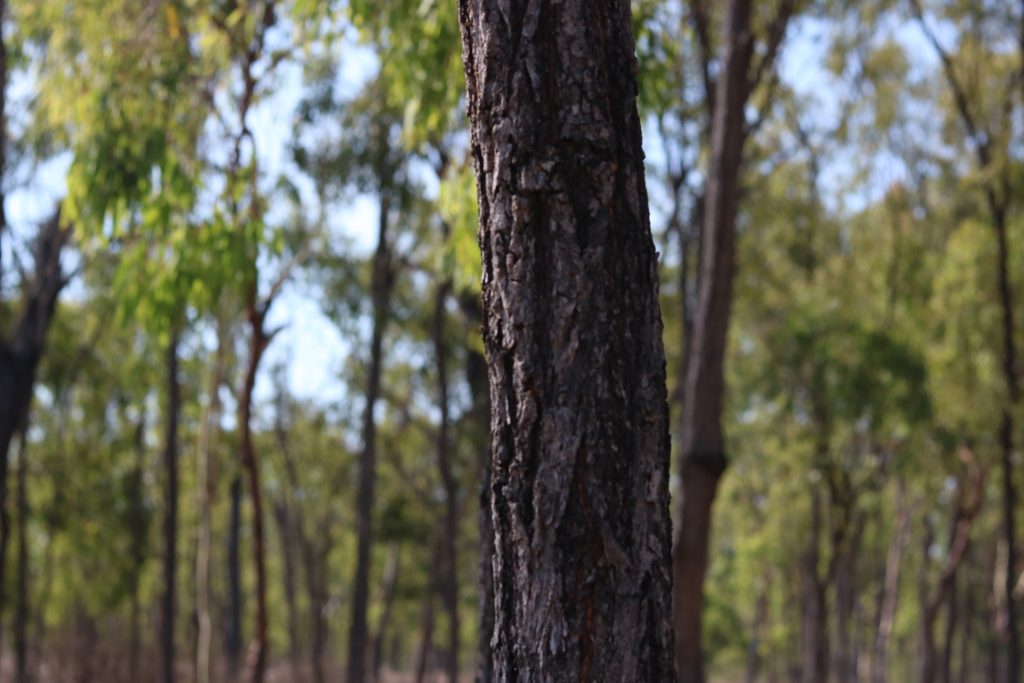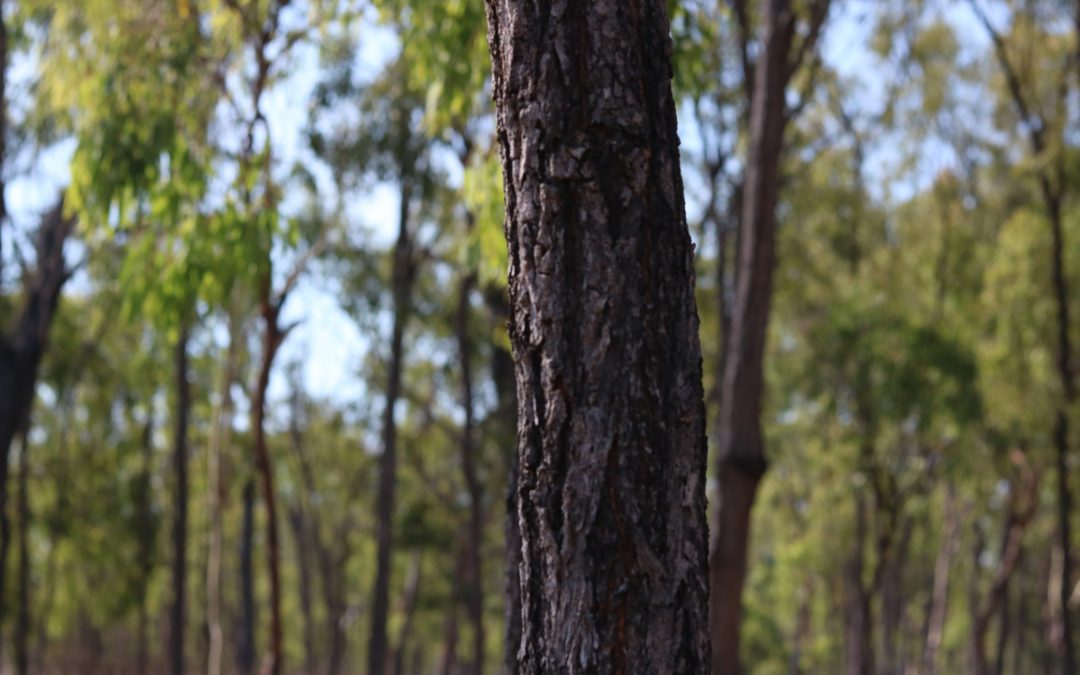It was a quiet afternoon at Camp Binbee – the exhausted recovery from the at times frantic activity of trying to stop Adani’s proposed mega coal mine. As the hot breeze rustled through the trees, a few of us sat down for tattoos. The medium was the “stick and poke” of a pot of ink and a steel needle. The design was modelled on the patterns that adorn the hundreds of ironbark trees dotted around the property; except this motif also incorporated lines from the topographical map of the surrounding area.

A bit abstract then, but these were undoubtedly Camp Binbee tattoos. The funny thing was though, the tattoos said nothing about coal mining, or blockading, or even protest. They were a permanent etching on our bodies not just of this campaign, but of this place. This hundred acres of scraggly eucalypt, cleared grassland and dry creekbeds that so many of us have, for varying lengths of time over the last couple of years, called home.
Every morning here, the daily meeting begins with an acknowledgement of country. It is a recognition of the Birri people who are the area’s traditional owners, unjustly dispossessed of this land long ago and still struggling to right those wrongs. But it is also, in a way consistent with that aboriginal culture, an acknowledgement of place – a reminder that we are in a specific site with its own characteristics, history, and needs. It is a grounding in where we are, a recognition that our life is entwined with the physical space we inhabit. It affects us, and we affect it.
Camp Binbee is in some ways a world unto itself. Isolated by distance from big cities and towns; and removed by intention from the everyday world of apathy, distraction and complicity that shields us from the reality of climate breakdown. It is a place where radical ideas and practices that are frequently marginalised can thrive. It is no overstatement to say this place has changed lives.
It’s a place where people have been able to find a community. A group of people who, purely by the fact of their awareness and desire for action, reassure that you are not crazy and we are indeed in a climate crisis that demands our attention. A community committed to taking personal responsibility for this crisis, to breaking through our conditioned apathy and holding to account those who are benefiting from the destruction of our planet. A community committed to working together – to resolving interpersonal disputes that arise, to making decisions by group consensus, to working on the parts of ourselves that affect others negatively. Binbee is a place where, if not always successfully, these processes are at least attempted and seen as important.
It is a place where close relationships are forged – lives lived together, hopes and fears explored, intense moments experienced with others in a way that can turn strangers very quickly into close friends. It is a place where we discover new sides of ourselves. Facing needs and opportunities we never had before; we find previously unknown abilities, passions and reserves of energy. Where the sharing of skills and knowledge is encouraged, even across the usual social determinants of gender or age.
It is a place that makes transformation visible. Permaculture principles turn a dry wasteland into a flourishing garden. Connection to a culture and history of political movements make social change seem possible. Encountering new ideas and experiences, we begin to feel ourselves change and believe that the way things are presently need not be how they have to be.
All this is not to say it is a perfect place. It can be frustrating, overwhelming, dysfunctional. People’s experiences of it wildly fluctuate depending on a whole range of factors. But what is certain is that Camp Binbee’s existence as a physical location allows for the possibility of things that would otherwise not exist. In a world where we are becoming ever more removed from our physical surroundings – where we spend increasingly more time in interchangeable buildings or suburbs, or in the altered reality of cyberspace; Camp Binbee is a reminder of the power of “Genius Loci” – the spirit of place.
At the same time there exists a tension. Most of the residents of Binbee over the last couple of years are not originally from this area and don’t envision our long term futures being spent here. When the campaign against Adani’s Carmichael mine concludes one way or another, nobody claims that Camp Binbee and all its wonderful characteristics will continue to have a purpose or even continue to exist.
We are frequently reminded of this fact by local politicians and voices in the media saying we are southern blow-ins who should have no say in what happens in central Queensland. The chorus repeated once again with Labor’s election review last week, of “Queenslanders don’t like being told what to do”.
The identity of place in this part of the world is strong – aided by the geographical distance from the big cities that hold more social and political influence in Australia. But it’s a sense of place that at times resembles a siege mentality – defined by the exclusion of outsiders. Recently it has manifested as a spirited defence of mining and its role in local industry.
That notion of locality though is manufactured by that placeless, mystical idea we call “economics”. The dynamics of monetary exchange certainly has a role to play in the formation of physical spaces, but it has no loyalty to them – witness the sadness of busted mining towns like Mt Morgan. Or the shift visible in places like Bowen – a town once built on a local industry of fruit pickers but now, unable to pay anyone a living wage, carrying a perpetual transient population of broke backpackers essentially doing indentured labour in order to get their visa extension.
Loyalty to an industry that has traditionally succeeded in that physical locality is not the same thing as a healthy attachment to an actual place. This can be discovered when the mines aren’t profitable any more and the multi-national companies that own them pack up and move, or when the outside world moves on and a blinkered community distrustful of outsiders suddenly discovers their sense of place was based on nothing after all. The panic caused by China refusing to buy Australian coal this year is a foreshadow of how this can happen.
More immediately, we can find our attachment to a theoretical place removes us from our actual surroundings. Central Queensland mine workers feeling threatened by calls for climate action find themselves claiming climate change is a myth, even a global conspiracy (those pesky outsiders again) – they state this again and again even as drought and unprecedented bushfires ravage the actual place they live. Great Barrier Reef tourism operators won’t allow anyone to talk about the issue of coral bleaching out of fear it will stop customers coming. Their local identity has become so distorted by economics they live out of touch with their surroundings, even out of touch with reality.
Climate change seems so emblematic of our society’s disconnection from place. Our lifestyles have caused drastic changes that affect our surroundings, yet some unseen force makes us unable to recognise or to change it. As sea levels rise, extreme weather events become more prevalent and weather patterns change; we find ourselves strangers even in once familiar places.
Though it is a global issue that has so far mostly been hindered by the parochialism of specific locations (think of Scott Morrison’s response to the UN last month: “We won’t be copping from any global institution any directions that are at odds with our national interest”); I still think that finding solutions to the climate crisis is somehow entwined with finding authentic ways of relating to the spaces we live in.
Grounding ourselves in the places we inhabit can be an act of climate resistance. It makes us more aware of how the climate is changing and the actions we need to take to adjust – or ideally to stop it.
But as Camp Binbee demonstrates in some small way, committing ourselves to the physical spaces around us can also be a powerful act of resistance because we are always influenced by our physical surroundings. We need to create spaces where people can develop new skills and ideas, where we can connect to a culture that enables us to believe change is possible and to a group of people that empowers us to make it happen. Spaces that can inspire and educate; that can enable people to push beyond societal norms, to attempt audacious things without fear of potential failure.
Climate change is potentially a worldwide threat unrivalled in human history. But as ever, the global and the local are entwined – to have a chance of stopping climate disaster, we need to be conscious of how we relate to the land beneath our feet.
– Andy Paine


Recent Comments